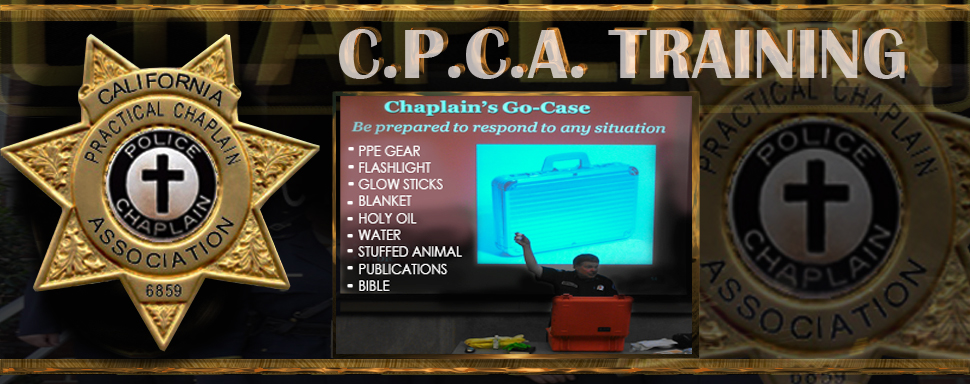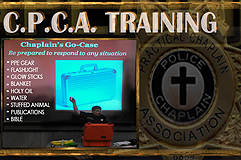California Practical Chaplain Association
THE CALIFORNIA PRACTICAL CHAPLAIN ASSOCIATION HAS BEEN A CERTIFIED PROVIDER OF CHAPLAIN CERTIFICATION BY P.O.S.T. (COMMISSION ON PEACE OFFICER STANDARDS AND TRAINING) FOR THE PAST 4 YEARS
CPCA CERTIFIED CHAPLAIN TRAINING FORMERLY CALIFORNIA P.O.S.T. CERTIFIED COURSE # 40010
The CPCA offers certified Chaplain Training Program to allow you to complete your goals in Chaplaincy by utilizing in class instruction and at home internet learning. The Course covers the following subjects required for Chaplain Certification:
Successful completion of the training will allow certification of the candidate in their designated field of Chaplaincy and candidates witll receive:
Certificate of Completion
Registration into our data bank for reference verification
Issued Identification Card
Verification Letter
Authorization For Purchase Of CPCA Badges and Uniforms
One Year Membership In the CPCA
CPCA CHAPLAIN CERTIFICATION COURSE
PART I
The Chaplain In The Community
The objective of this portion of the course is to enable the Chaplain to more easily understand his/her position in the community. Understanding the need for balance in the areas of Public Prayer, The Chaplain's Image, Denominational Attitudes (Sectarianism), Respect For The Faith Of Others, Non-Christian Religions, Our Relationship To Non-Christian Chaplains, and Becoming More Easily Integrated As A Vital Force In The Community And The Workplace.
Women In Chaplaincy
Women in Chaplaincy have become a vital force in the Workplace Chaplaincy effort. Specific cautions and restrictions are, at times, imposed upon the female Chaplain. In order for her to function professionally, the Chaplain must learn to function within the guidelines of the institution without taking on unnecessary limitations.
The Chaplain In The Workplace
This portion of the course deals with the perception of the Chaplain by other workers and the necessity that the Chaplain maintains a proper image and perspective.
The Chaplain's Role With EAP
While by nature, the Chaplain is a helper and wants to be the one to solve the problems of the world, reality dictates limitations on the help we are able to administer. One such area is the realm of the EAP (Employee Assistance Program) Representative. The Chaplain must work in concord with the EAP Representative. This relational position will be discussed in depth.
Equipment Needs Of The Chaplain
These differ with the type of Chaplaincy. However, there are certain elements that are common to the field of Chaplaincy and the Chaplain should equip himself/herself to meet the emergency situation in the most prepared and comfortable fashion at his/her disposal. This portion addresses the expected and unexpected needs that should help the Chaplain become professionally prepared.
Spirituality And The Chaplain
The Chaplain must be "Called" and he/she must maintain a spiritual attitude (not a religious attitude) and guard the image of the Ministry. The Chaplain must maintain a working relationship with Christ, just as he/she must maintain a working relationship with those whom he/she ministers to.
Evangelism
There is a time and a place for everything. This portion of the course deals with the issue of evangelism in the workplace. What is proper? What is not proper?
Counseling
The work of the Chaplain is centred on counseling. The Chaplain must learn to differentiate between the of the roles of "Trained Certified Counselor" and "Pastoral Counselor". Limitations do apply on the role of the counseling Chaplain. This area will be discussed in depth.
The Chaplain And Governmental Restrictions
It is imperative that the working Chaplain keeps abreast of the laws and mandates governing his/her work. This portion of the course is designed to be informative and stimulating. This should give the Chaplain direction to remain informed about changes and trends of laws in regards to Chaplaincy.
PART II
Ethics And Responsibility
-This portion of the course deals with the ethical responsibility of the Chaplain to the agency, institution, or industry that he/she is serving or employed by. It also deals with the issue of continuing education and enhancement of one's ministry.
Privilege And Confidentiality
This position of Chaplaincy often allows the Chaplain access to privileged or private information. This portion of the course deals with issues facing the Chaplain and in the workplace and the aspects of confidentiality that must be understood by the Chaplain.
Listening
The Chaplain must cultivate listening skills in order to serve the people entrusted to his/her care. This portion of the course deals with how to enhance the Chaplains listening skills and ability to "hear" the people that he/she works with.
PART III
Emergency Service Worker Profile
There are certain characteristics that are common to emergency service workers, be they Law Enforcement, EMT, EAP, Pastors, Chaplains, or Church Helps Workers. An understanding of thoses characteristics is helpful to the Chaplain in working with others who are involved in Emergency Service, as well as understanding "Why do I do the things I do?"
PART IV
Grief and Loss
All who live must at some time suffer the pain of grief and the desolation of loss. The Chaplain will often be faced with troubled and pain stricken employees and those who seek counsel. A good grasp of the principles of Grief and Loss and understanding the Grief Cycle are imperative for the working Chaplain.
Death Notifications
This portion is perhaps the most unpleasant aspect of Chaplaincy, and yet the most common of the recognized use of the Chaplain. It behooves the Chaplain to know the proper way to deliver a death notification. There is no pleasant way, but there are some very wrong ways.
SECTION V
Trauma
Traumatic experiences catch us unaware. The Chaplain should understand the dynamics and the effects of Trauma in order to properly direct the employee to the resources that are available to serve the need.
Critical Incident Stress
Critical Incident Stress related issues are of primary importance to the Chaplain. The areas that will be addressed in this section of the course are Critical Incident Stress, Critical Incident Stress Management, and Critical Incident Stress Debriefing. The issue encompasses the incident, symptoms, immediate intervention, treatment and long-term follow up.
Post Traumatic Stress Disorder
If not treated promptly and properly, Trauma and Critical Incident Issues can result in Post-Traumatic Stress Disorder. This disorder will be discussed in depth.
Depression
Depression is an area that the Chaplain must learn to recognize. The Chaplain will often be called upon to set up resources to provide intervention and treatment.
Divorce
Divorce and separation are common areas of concern in the work of the Chaplain. Counsel and resources are needed in order to properly serve the employee.
Substance Abuse
Substance abuse is a major problem in the workplace in today's society. The Chaplain must keep well informed of current substance abuse problems and treatment. He/she must be able to provide counsel, resources and treatment options to the employees in order to properly minister to their needs.
Suicide
This is a difficult and, at times, controversial issue for the Chaplain to deal with. Theological debate is out of order in the presence of such a painful issue. The Chaplain must meet the need of the family victims at such a time and put theological issues aside for another time and place. Many suffering families have been turned from church and God by the actions of hard-core attitudes concerning this issue.
Establishing Resources And Allies
"Support" is the key word in Chaplaincy. Often, Chaplains try to "do it all" and cannot properly serve because they have failed to understand the importance of establishing a strong "Support and Allies" foundation. This portion of the course deals with the necessity of "Support and Allies" and how to establish and cultivate that portion of Chaplaincy.



